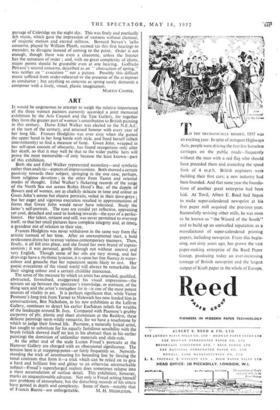ART
IT would be ungenerous to attempt to weigh the relative importance of the three women painters currently accorded a joint memorial exhibition by the Arts Council and the Tate Gallery, for together they form the greater part of woman's contribution to British painting in this century. Dame Ethel Walker was elected to the N.E.A.C. at the turn of the century, and amassed honour with every year of her long life. Frances Hodgkins was over sixty when she gained the upper hand in her long battle with style, and freed herself (albeit intermittently) to find a measure of fame. Gwen John, wrapped in her self-spun cocoon of obscurity, has found recognition only after her death, so that it may well be that to the wider public hers will prove the most memorable—if only because the least known—part of this exhibition.
Both she and Ethel Walker represented secondary—and synthetic rather than analytic—aspects of impressionism. Both showed a certain passivity towards their subject, springing in the one case, perhaps, from religious devotion ; in the other from Taoist and oriental modes of thought. Ethel Walker's flickering records of the surge of the North Sea out across Robin Hood's Bay, of the dapple of flowers and of women, are as chalkily delicate in tone and colour as Gwen John's serene but elusive portraits, veiled in their dove-greys ; but her eager and vigorous execution resulted in approximations of forms that Gwen John would never have tolerated. Study the latter's self-portrait. The eyes are candid yet reflective, appraising yet cool, detached and used to looking inwards—the eyes of a perfec- tionist. Her talent, reticent and still, was never permitted to overstep itself, so that her small pictures have complete integrity and, at timq„ a grandeur out of relation to their size.
Frances Hodgkins was never withdrawn in the same way from the artistic turmoil of her time. After an unexceptional start, a bold restlessness drove her to essay Various contemporary manners. Then, finally, it all fell into place, and she found her own brand of expres- sionism; it was personal, gentle (though not without sinews) and very English. Though some of her oils are very strong, and her drawings have a rhythmic lyricism, it is upon her fine fluency in water- colour and gouache that her reputation seems likely to rest. Her poetic evocations of the visual world will always be remarkable for their singing colour and a certain childlike innocence.
The sense of the measure by which an artist has amended, qualified, abstracted, formalised, exaggerated his visua.1, impressions—the tension set up between the spectator's knowledge, or estimate, of the thing seen and the artist's metaphor for it—is one of the most potent sources of vitality in art. It is perhaps significant that, while Victor Pasmore's long trek from Turner to Malewich has now landed him in constructivism, Ben Nicholson, in his new exhibition at the Lefevre Gallery, continues to desert his earlier Euclidean reliefs for wraiths of the landscape around St. Ives. Compared with Pasmore's grubby carpentry of ply, plastic and sheet aluminium at the Redfern, these delicate paintings seem wildly romantic, for we have a touchstone by which to judge their formal life. Pasmore, a naturally lyrical artist, has sought to substitute for his equally fastidious sensibility with the brush (which showed itself no less in his abstract than in his earlier painting) the dominion of unfamiliar materials and slide-rule.
At the other end of the scale Lucien Freud's portraits at the Hanover Gallery are charged with an obsessional significance. The tension here is at snapping-point--or fairly frequently so. Notwith- standing the trick of accentuating his bounding line by forcing the tonal contrasts that form it—a trick which can be relied on to give a hard and brilliant bite and glitter to an otherwise unremarkable subject—Freud's supercharged realism does sometimes relapse into a mere accumulation of surface detail. This exhibition, however, marks an unquestionable advance. Not only is Freud setting himself new problerns of atmosphere, but the disturbing records of his sitters have gained in depth and complexity. Some of them—notably that of Francis Bacon—are unforgettable. M. H. MIDDLETON.


































 Previous page
Previous page